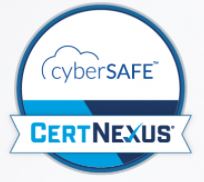Duration: 0.5 Day

Regardless of your computer experience, CyberSecurity Awareness training will help you become more aware of technology-related risks and what you can do to protect yourself and your organization from them.
This course will help you to:
- Understand both security and compliance needs and requirements.
- Recognize and avoid phishing and other social engineering attempts.
- Recognize and avoid viruses, ransomware, and other malware.
- Help ensure data security on computers, mobile devices, networks, the Internet, and in the cloud.
In this course, you will use discussions, case studies, and the experiences of your instructor and fellow students to explore the hazards and pitfalls of technology and learn how to use that technology safely and securely.
Course Objectives
In this course, you will identify many of the common risks involved in using conventional computing
technology, as well as ways to use it safely, to protect yourself from those risks. You will:
- Identify security compliance measures.
- Address social engineering attempts.
- Secure devices such as desktops, laptops, tablets, smartphones, and more.
- Use the Internet securely.
Target Student
This course is designed for all users of computers, mobile devices, networks, and the Internet, to enable them to use technology more securely and minimize digital risks, regardless of technical ability. This course is also designed for you to prepare for the CyberSAFE credential. At the end of the training, you have the option to take the online certification exam to obtain your CyberSAFE certificate.
Prerequisites
To ensure your success in this course, you should have experience with the basic use of conventional computing technology, including desktop, laptop, or tablet computers; mobile phones; and basic Internet functions, such as web browsing and email.
Course Content
Lesson 1: Identifying Security Compliance Measures
- Identify Organizational Compliance Requirements and Resources
- Identify Legal Compliance Requirements and Resources
Lesson 2: Recognizing and Addressing Social Engineering Attack
- Recognize Social Engineering Attacks
- Defend Against Social Engineering Attacks
Lesson 3: Securing Devices
- Maintain Physical Security of Devices
- Use Secure Authentication Methods
- Protect Your Data
- Defend Against Malware
- Use Wireless Devices Securely
Lesson 4: Using the Internet Securely
- Browse the Web Safely
- Use Email Securely
- Use Social Networks Securely
- Use Cloud Services Securely
- Work from Remote Locations Securely


